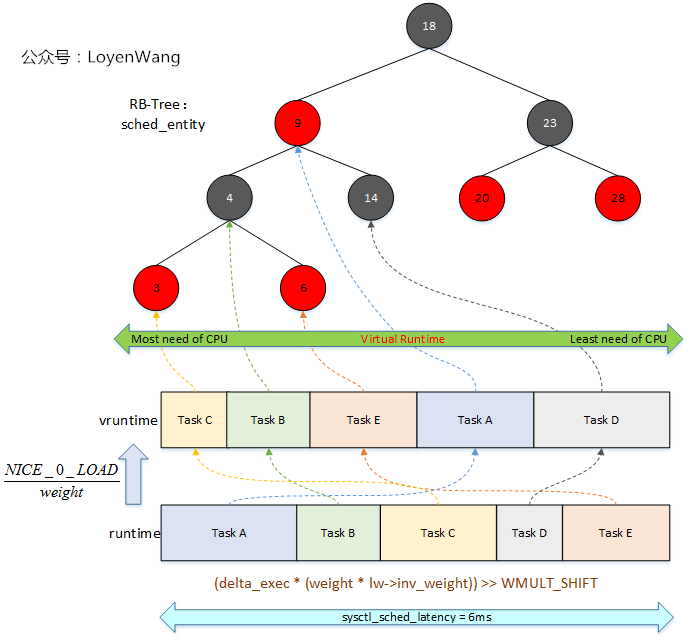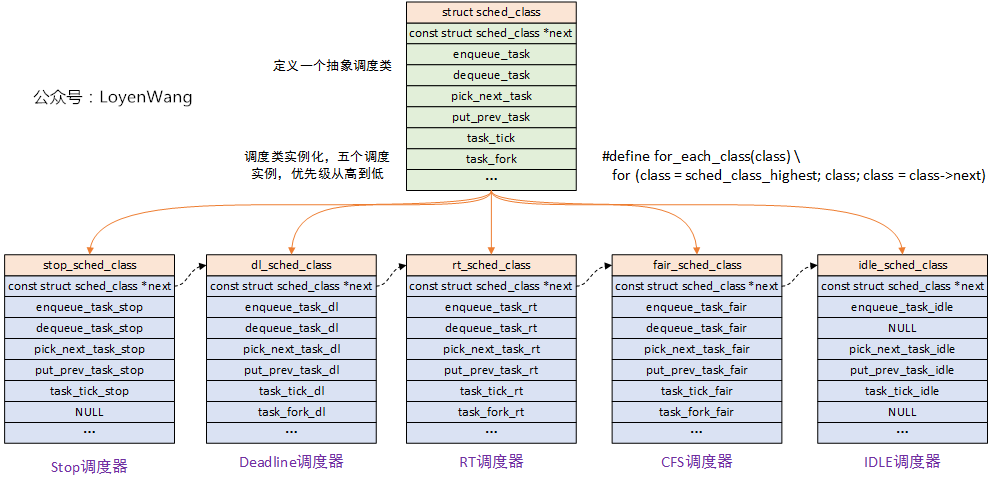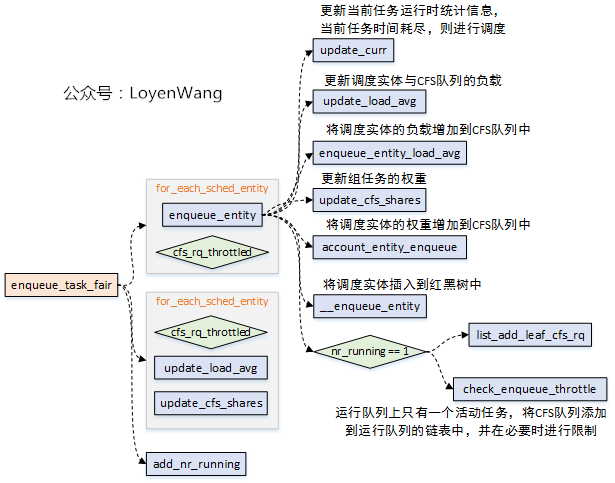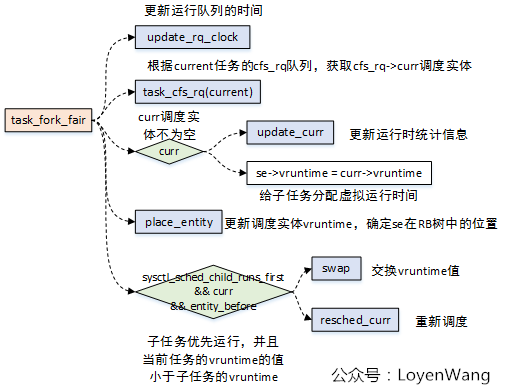【原创】(五)Linux进程调度-CFS调度器
- 2020 年 3 月 15 日
- 筆記
背景
Read the fucking source code!–By 鲁迅A picture is worth a thousand words.–By 高尔基
说明:
- Kernel版本:4.14
- ARM64处理器,Contex-A53,双核
- 使用工具:Source Insight 3.5, Visio
1. 概述
Completely Fair Scheduler,完全公平调度器,用于Linux系统中普通进程的调度。CFS采用了红黑树算法来管理所有的调度实体sched_entity,算法效率为O(log(n))。CFS跟踪调度实体sched_entity的虚拟运行时间vruntime,平等对待运行队列中的调度实体sched_entity,将执行时间少的调度实体sched_entity排列到红黑树的左边。- 调度实体
sched_entity通过enqueue_entity()和dequeue_entity()来进行红黑树的出队入队。
老规矩,先上张图片来直观了解一下原理:

- 每个
sched_latency周期内,根据各个任务的权重值,可以计算出运行时间runtime; - 运行时间
runtime可以转换成虚拟运行时间vruntime; - 根据虚拟运行时间的大小,插入到CFS红黑树中,虚拟运行时间少的调度实体放置到左边;
- 在下一次任务调度的时候,选择虚拟运行时间少的调度实体来运行;
在开始本文之前,建议先阅读下(一)Linux进程调度器-基础。
开始探索之旅!
2. 数据结构
2.1 调度类
Linux内核抽象了一个调度类struct sched_class,这是一种典型的面向对象的设计思想,将共性的特征抽象出来封装成类,在实例化各个调度器的时候,可以根据具体的调度算法来实现。这种方式做到了高内聚低耦合,同时又很容易扩展新的调度器。

- 在调度核心代码
kernel/sched/core.c中,使用的方式是task->sched_class->xxx_func,其中task表示的是描述任务的结构体struct task_struck,在该结构体中包含了任务所使用的调度器,进而能找到对应的函数指针来完成调用执行,有点类似于C++中的多态机制。
2.2 rq/cfs_rq/task_struct/task_group/sched_entity
struct rq:每个CPU都有一个对应的运行队列;struct cfs_rq:CFS运行队列,该结构中包含了struct rb_root_cached红黑树,用于链接调度实体struct sched_entity。rq运行队列中对应了一个CFS运行队列,此外,在task_group结构中也会为每个CPU再维护一个CFS运行队列;struct task_struct:任务的描述符,包含了进程的所有信息,该结构中的struct sched_entity,用于参与CFS的调度;struct task_group:组调度(参考前文),Linux支持将任务分组来对CPU资源进行分配管理,该结构中为系统中的每个CPU都分配了struct sched_entity调度实体和struct cfs_rq运行队列,其中struct sched_entity用于参与CFS的调度;struct sched_entity:调度实体,这个也是CFS调度管理的对象了;
来一张图看看它们之间的组织关系:

struct sched_entity结构体字段注释如下:
struct sched_entity { /* For load-balancing: */ struct load_weight load; //调度实体的负载权重值 struct rb_node run_node; //用于连接到CFS运行队列的红黑树中的节点 struct list_head group_node; //用于连接到CFS运行队列的cfs_tasks链表中的节点 unsigned int on_rq; //用于表示是否在运行队列中 u64 exec_start; //当前调度实体的开始执行时间 u64 sum_exec_runtime; //调度实体执行的总时间 u64 vruntime; //虚拟运行时间,这个时间用于在CFS运行队列中排队 u64 prev_sum_exec_runtime; //上一个调度实体运行的总时间 u64 nr_migrations; //负载均衡 struct sched_statistics statistics; //统计信息 #ifdef CONFIG_FAIR_GROUP_SCHED int depth; //任务组的深度,其中根任务组的深度为0,逐级往下增加 struct sched_entity *parent; //指向调度实体的父对象 /* rq on which this entity is (to be) queued: */ struct cfs_rq *cfs_rq; //指向调度实体归属的CFS队列,也就是需要入列的CFS队列 /* rq "owned" by this entity/group: */ struct cfs_rq *my_q; //指向归属于当前调度实体的CFS队列,用于包含子任务或子的任务组 #endif #ifdef CONFIG_SMP /* * Per entity load average tracking. * * Put into separate cache line so it does not * collide with read-mostly values above. */ struct sched_avg avg ____cacheline_aligned_in_smp; //用于调度实体的负载计算(`PELT`) #endif };- struct cfs_rq结构体的关键字段注释如下:
/* CFS-related fields in a runqueue */ struct cfs_rq { struct load_weight load; //CFS运行队列的负载权重值 unsigned int nr_running, h_nr_running; //nr_running:运行的调度实体数(参与时间片计算) u64 exec_clock; //运行时间 u64 min_vruntime; //最少的虚拟运行时间,调度实体入队出队时需要进行增减处理 #ifndef CONFIG_64BIT u64 min_vruntime_copy; #endif struct rb_root_cached tasks_timeline; //红黑树,用于存放调度实体 /* * 'curr' points to currently running entity on this cfs_rq. * It is set to NULL otherwise (i.e when none are currently running). */ struct sched_entity *curr, *next, *last, *skip; //分别指向当前运行的调度实体、下一个调度的调度实体、CFS运行队列中排最后的调度实体、跳过运行的调度实体 #ifdef CONFIG_SCHED_DEBUG unsigned int nr_spread_over; #endif #ifdef CONFIG_SMP /* * CFS load tracking */ struct sched_avg avg; //计算负载相关 u64 runnable_load_sum; unsigned long runnable_load_avg; //基于PELT的可运行平均负载 #ifdef CONFIG_FAIR_GROUP_SCHED unsigned long tg_load_avg_contrib; //任务组的负载贡献 unsigned long propagate_avg; #endif atomic_long_t removed_load_avg, removed_util_avg; #ifndef CONFIG_64BIT u64 load_last_update_time_copy; #endif #ifdef CONFIG_FAIR_GROUP_SCHED /* * h_load = weight * f(tg) * * Where f(tg) is the recursive weight fraction assigned to * this group. */ unsigned long h_load; u64 last_h_load_update; struct sched_entity *h_load_next; #endif /* CONFIG_FAIR_GROUP_SCHED */ #endif /* CONFIG_SMP */ #ifdef CONFIG_FAIR_GROUP_SCHED struct rq *rq; /* cpu runqueue to which this cfs_rq is attached */ //指向CFS运行队列所属的CPU RQ运行队列 /* * leaf cfs_rqs are those that hold tasks (lowest schedulable entity in * a hierarchy). Non-leaf lrqs hold other higher schedulable entities * (like users, containers etc.) * * leaf_cfs_rq_list ties together list of leaf cfs_rq's in a cpu. This * list is used during load balance. */ int on_list; struct list_head leaf_cfs_rq_list; struct task_group *tg; /* group that "owns" this runqueue */ //CFS运行队列所属的任务组 #ifdef CONFIG_CFS_BANDWIDTH int runtime_enabled; //CFS运行队列中使用CFS带宽控制 u64 runtime_expires; //到期的运行时间 s64 runtime_remaining; //剩余的运行时间 u64 throttled_clock, throttled_clock_task; //限流时间相关 u64 throttled_clock_task_time; int throttled, throttle_count; //throttled:限流,throttle_count:CFS运行队列限流次数 struct list_head throttled_list; //运行队列限流链表节点,用于添加到cfs_bandwidth结构中的cfttle_cfs_rq链表中 #endif /* CONFIG_CFS_BANDWIDTH */ #endif /* CONFIG_FAIR_GROUP_SCHED */ };3. 流程分析
整个流程分析,围绕着CFS调度类实体:fair_sched_class中的关键函数来展开。
先来看看fair_sched_class都包含了哪些函数:
/* * All the scheduling class methods: */ const struct sched_class fair_sched_class = { .next = &idle_sched_class, .enqueue_task = enqueue_task_fair, .dequeue_task = dequeue_task_fair, .yield_task = yield_task_fair, .yield_to_task = yield_to_task_fair, .check_preempt_curr = check_preempt_wakeup, .pick_next_task = pick_next_task_fair, .put_prev_task = put_prev_task_fair, #ifdef CONFIG_SMP .select_task_rq = select_task_rq_fair, .migrate_task_rq = migrate_task_rq_fair, .rq_online = rq_online_fair, .rq_offline = rq_offline_fair, .task_dead = task_dead_fair, .set_cpus_allowed = set_cpus_allowed_common, #endif .set_curr_task = set_curr_task_fair, .task_tick = task_tick_fair, .task_fork = task_fork_fair, .prio_changed = prio_changed_fair, .switched_from = switched_from_fair, .switched_to = switched_to_fair, .get_rr_interval = get_rr_interval_fair, .update_curr = update_curr_fair, #ifdef CONFIG_FAIR_GROUP_SCHED .task_change_group = task_change_group_fair, #endif };3.1 runtime与vruntime
CFS调度器没有时间片的概念了,而是根据实际的运行时间和虚拟运行时间来对任务进行排序,从而选择调度。
那么,运行时间和虚拟运行时间是怎么计算的呢?看一下流程调用:

- Linux内核默认的
sysctl_sched_latency是6ms,这个值用户态可设。sched_period用于保证可运行任务都能至少运行一次的时间间隔; - 当可运行任务大于8个的时候,
sched_period的计算则需要根据任务个数乘以最小调度颗粒值,这个值系统默认为0.75ms; - 每个任务的运行时间计算,是用
sched_period值,去乘以该任务在整个CFS运行队列中的权重占比; - 虚拟运行的时间 = 实际运行时间 * NICE_0_LOAD / 该任务的权重;
还是来看一个实例吧,以5个Task为例,其中每个Task的nice值不一样(优先级不同),对应到的权重值在内核中提供了一个转换数组:
const int sched_prio_to_weight[40] = { /* -20 */ 88761, 71755, 56483, 46273, 36291, /* -15 */ 29154, 23254, 18705, 14949, 11916, /* -10 */ 9548, 7620, 6100, 4904, 3906, /* -5 */ 3121, 2501, 1991, 1586, 1277, /* 0 */ 1024, 820, 655, 526, 423, /* 5 */ 335, 272, 215, 172, 137, /* 10 */ 110, 87, 70, 56, 45, /* 15 */ 36, 29, 23, 18, 15, };图来了:

3.2 CFS调度tick
CFS调度器中的tick函数为task_tick_fair,系统中每个调度tick都会调用到,此外如果使用了hrtimer,也会调用到这个函数。
流程如下:

主要的工作包括:
- 更新运行时的各类统计信息,比如
vruntime, 运行时间、负载值、权重值等; - 检查是否需要抢占,主要是比较运行时间是否耗尽,以及
vruntime的差值是否大于运行时间等;
来一张图,感受一下update_curr函数的相关信息更新吧:

3.3 任务出队入队
- 当任务进入可运行状态时,需要将调度实体放入到红黑树中,完成入队操作;
- 当任务退出可运行状态时,需要将调度实体从红黑树中移除,完成出队操作;
- CFS调度器,使用
enqueue_task_fair函数将任务入队到CFS队列,使用dequeue_task_fair函数将任务从CFS队列中出队操作。

- 出队与入队的操作中,核心的逻辑可以分成两部分:1)更新运行时的数据,比如负载、权重、组调度的占比等等;2)将sched_entity插入红黑树,或者从红黑树移除;
- 由于
dequeue_task_fair大体的逻辑类似,不再深入分析; - 这个过程中,涉及到了
CPU负载计算、task_group组调度、CFS Bandwidth带宽控制等,这些都在前边的文章中分析过,可以结合进行理解;
3.3 任务创建
在父进程通过fork创建子进程的时候,task_fork_fair函数会被调用,这个函数的传入参数是子进程的task_struct。该函数的主要作用,就是确定子任务的vruntime,因此也能确定子任务的调度实体在红黑树RB中的位置。
task_fork_fair本身比较简单,流程如下图:

3.4 任务选择
每当进程任务切换的时候,也就是schedule函数执行时,调度器都需要选择下一个将要执行的任务。
在CFS调度器中,是通过pick_next_task_fair函数完成的,流程如下:

- 当需要进程任务切换的时候,
pick_next_task_fair函数的传入参数中包含了需要被切换出去的任务,也就是pre_task; - 当
pre_task不是普通进程时,也就是调度类不是CFS,那么它就不使用sched_entity的调度实体来参与调度,因此会执行simple分支,通过put_pre_task函数来通知系统当前的任务需要被切换,而不是通过put_prev_entity函数来完成; - 当
pre_task是普通进程时,调用pick_next_entity来选择下一个执行的任务,这个选择过程实际是有两种情况:当调度实体对应task时,do while()遍历一次,当调度实体对应task_group是,则需要遍历任务组来选择下一个执行的任务了。 put_prev_entity,用于切换任务前的准备工作,更新运行时的统计数据,并不进行dequeue的操作,其中需要将CFS队列的curr指针置位成NULL;- set_next_entity,用于设置下一个要运行的调度实体,设置CFS队列的
curr指针; - 如果使能了
hrtimer,则将hrtimer的到期时间设置为调度实体的剩余运行时间;
暂且分析到这吧,CFS调度器涵盖的内容还是挺多的,fair.c一个文件就有将近一万行代码,相关内容的分析也分散在前边的文章中了,感兴趣的可以去看看。
打完收工,洗洗睡了。


